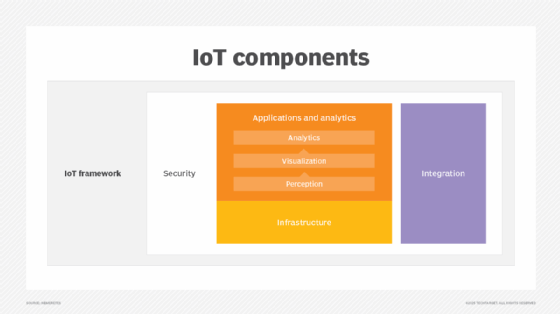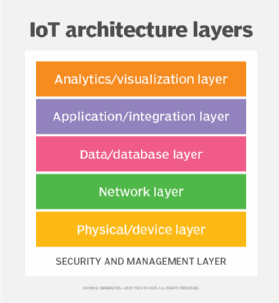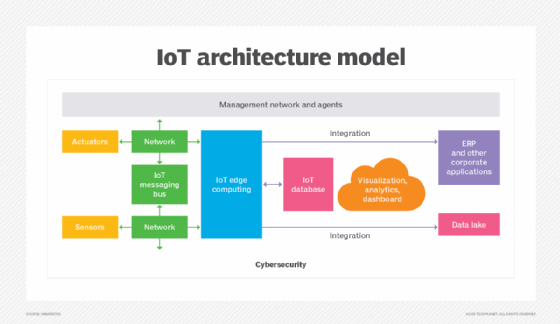6 IoT architecture layers and components explained
Having a clearly defined IoT architecture framework greatly improves the chances for success of an enterprise's connected deployment.
Enterprise IoT continues to grow at a reported 20% annually, transforming operations across various industries, from manufacturing and logistics to healthcare and energy. As this expansion accelerates, enterprise IT and operational technology professionals must prepare to design, implement and manage increasingly complex IoT systems.
The first step in achieving this is to determine the business purpose of IoT within the organization. That purpose could be to drive revenue, cut costs, optimize business processes, enhance safety or support strategic innovation. Once the purpose is clear, the next step is to develop the architecture. Although there is no one-size-fits-all approach, it makes sense to build a general architecture that includes all components that can be standardized across the organization and then develop specific architectures tailored to meet individual business objectives.
What is IoT architecture?
At its core, IoT architecture is the structured design that defines the components of an IoT system and how they interact. It encompasses the individual technology components -- hardware, software and services -- and the relationships between them.
An architecture isn't simply a catalog of parts; it's a model that shows how those parts communicate and collaborate. For example, a cloud platform isn't a component by itself, but a cloud-hosted analytics engine is. Likewise, a smart sensor or actuator becomes part of the architecture only when it delivers a defined technical capability in the system.
Understanding and visualizing these relationships ensures interoperability, scalability and security across a connected ecosystem.
What are the components of IoT architecture?
Although individual deployments might vary, most IoT architectures share four major components (see Figure 1).

Security and management component
The security and management component safeguards IoT devices, networks and data flows using firmware protection, encryption, access controls and continuous monitoring. Key vendors include Palo Alto Networks, Forescout, Cisco, Alkira and Zscaler.
Applications and analytics component
The applications and analytics component is the intelligence hub of the IoT architecture, responsible for processing, analyzing and visualizing the data collected from sensors and edge devices. It encompasses not only traditional analytics and machine learning (ML) tools but also integrates multiple architectural sublayers, including the analytics layer, visualization layer and perception layer.
Together, these sublayers enable IoT systems to collect and transmit data, derive real-time insights, visualize outcomes and take intelligent actions, forming the cognitive and operational foundation for smart environments in industries such as healthcare, manufacturing, logistics and smart cities.
Infrastructure component
The infrastructure component encompasses all physical and virtual systems supporting IoT data generation and transmission, including sensors, actuators, gateways and the networks that interconnect them (Wi-Fi, 5G/6G, Bluetooth, long-range WAN, wireless WAN, etc.).
Integration component
The integration component ensures smooth data and service exchange between IoT applications and enterprise IT systems -- for example, ERP, CRM or enterprise asset management tools. Integration often relies on middleware tools, such as Apache Kafka and Oracle Fusion Middleware, or open source IoT platforms, such as LinkSmart.
The second part of the architecture is the relationship between the components, meaning how components communicate with each other and what sorts of information are exchanged. This can include data flow, metadata flow, control information or no information at all. Software components often communicate using APIs, and the network component layer typically communicates using network protocols.
Architects often think in terms of component layers. These layers could include the network layer, perception layer, processing layer, physical layer, gateway layer, platform layer, device layer, business layer, security layer and sensor layer, for example.
The concept of a layer is that it comprises a set of capabilities that communicate with one another but -- for the purpose of other components -- can be treated as a single entity, with a single transparent entity.
For instance, in an IoT architecture, the application layer doesn't need to know what type of physical network carries the data. All network devices comprise the network layer, which transports traffic as required by the applications.
What are the 6 layers of IoT architecture?
The six layers of IoT architecture are as described below. Note that, in some cases, layers are composed of sublayers; this is a common characteristic in complex architectures, such as that of IoT (see Figure 2).
1. Physical/device layer
The physical layer comprises all sensors, actuators and other smart devices. These smart devices either capture data (sensors) or take action (actuators) or sometimes both.

2. Network layer
The network layer encompasses network devices, communication types and protocols. Although many IoT architectures rely on general-purpose network layers, there's an increasing trend toward moving to IoT-specific networks. This is especially true in environments that contain many dedicated IoT devices, such as factory floors and transportation distribution centers.
3. Data/database layer
The data layer also includes the database platform. There's a range of database platforms used for IoT architectures, and many organizations spend a fair amount of time selecting and architecting the right IoT databases. Together, the physical/device layer, network layer and data/database layer comprise the infrastructure component discussed above.
4. Analytics/visualization layer
In essence, this layer's focus is on analyzing the data collected by IoT and providing it to users and applications to make sense of. It comprises three sublayers:
- Analytics layer. The analytics layer applies advanced algorithms, statistical models and ML to extract actionable insights from raw IoT data. This can include predictive maintenance models, anomaly detection systems and optimization algorithms that inform real-time decision-making. Tools and platforms such as R, SAS, SPSS and Python-based frameworks (such as Scikit-learn or TensorFlow) are common here, alongside cloud-native AI and ML services -- including AWS SageMaker, Azure Machine Learning Studio, Google Cloud's Vertex AI and IBM Watson.
- Visualization layer. The visualization layer translates processed data into meaningful dashboards and graphical interfaces, enabling stakeholders to monitor, interact with and make decisions based on real-time IoT metrics. These visual interfaces range from mobile apps to enterprise-level dashboards, incorporating tools such as Grafana, Power BI, Tableau, Kibana and custom cloud dashboards offered by leading cloud providers.
- Perception layer. Although typically associated with the physical sensing component in an IoT stack, the perception layer is logically connected to the application and analytics component, as it defines how data is initially captured and contextualized. It includes environmental sensors, RFID tags, cameras or biometric devices, all of which generate the data that feeds the analytics engine. In advanced deployments, perception-layer feedback is also incorporated into analytics algorithms, enabling adaptive sensing and context-aware computing.
5. Application/integration layer
Applications and platforms work together to deliver functionality from the IoT infrastructure to the business. In other words, the application layer, platform layer and integration layer provide business value derived from the IoT infrastructure. The processing and business layers are key components of the broader application or integration layer.
6. Security and management layer
Strictly speaking, this isn't a layer but rather connects with all the other layers to provide security and management. It's an essential element that must be considered at every layer.
These six layers go from bottom to top, like the Open Systems Interconnection model, which was the original source of the layering concept (see Figure 3).

Conclusion and recommendations
Enterprise IT, operational technology and IoT leaders should base IoT deployments on a consistent, layered architecture. That doesn't require identical technology stacks, but it does demand a shared understanding of the IoT architecture layers and how they support business outcomes.
When designing or evaluating an IoT system, ensure the architecture does the following:
- Covers all six layers, from physical to application.
- Supports scalable data and analytics workflows.
- Embeds security at every level.
- Integrates with enterprise IT environments.
- Enables device lifecycle management and real-time operations.
A clear architecture model not only accelerates deployment but also ensures long-term success, resilience and ROI in a rapidly evolving IoT landscape.
Editor's note: This article was originally written by Johna Till Johnson and updated in July 2025 by Jerald Murphy.
Jerald Murphy is senior vice president of research and consulting with Nemertes Research. With more than three decades of technology experience, Murphy has worked on a range of technology topics, including neural networking research, integrated circuit design, computer programming and global data center design. He was also the CEO of a managed services company.
Johna Till Johnson is CEO and founder of strategic consulting and research company Nemertes, where she sets research direction and works with strategic clients.







